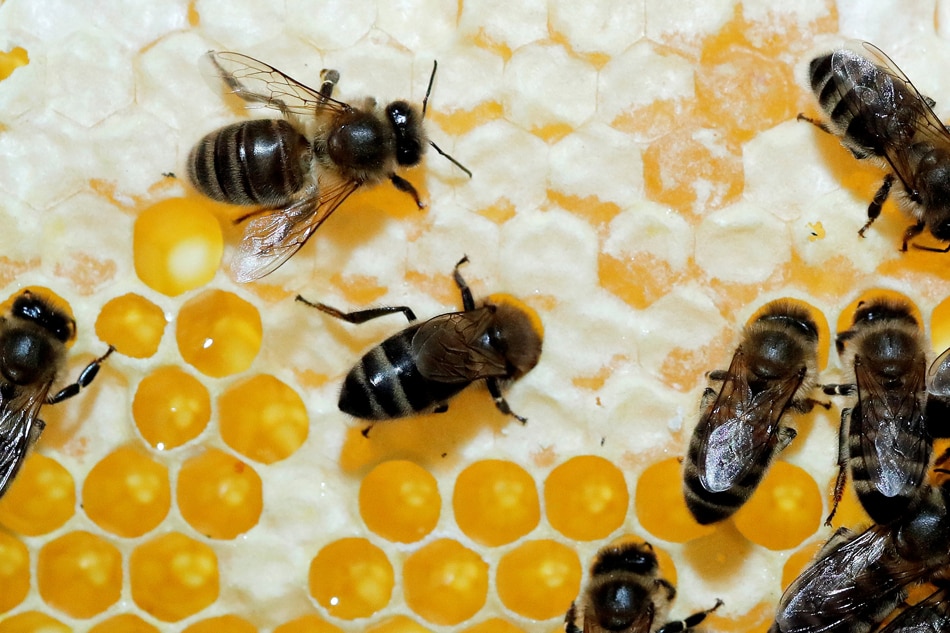Honey bees use poop power to repel hornet invaders
ADVERTISEMENT

Welcome, Kapamilya! We use cookies to improve your browsing experience. Continuing to use this site means you agree to our use of cookies. Tell me more!
Honey bees use poop power to repel hornet invaders
Agence France-Presse
Published Dec 10, 2020 07:02 AM PHT
WASHINGTON - It's certainly one way to defend your home.
WASHINGTON - It's certainly one way to defend your home.
Scientists have observed that Asian honey bees collect chicken feces, buffalo dung and even human urine, then smear it around the entrances of their nests to stop attacks from marauding giant hornets.
Scientists have observed that Asian honey bees collect chicken feces, buffalo dung and even human urine, then smear it around the entrances of their nests to stop attacks from marauding giant hornets.
The pungent practice is the first documented case of honey bees collecting non-plant matter, and the first clear example that they can use a "tool" (in this case, excrement).
The pungent practice is the first documented case of honey bees collecting non-plant matter, and the first clear example that they can use a "tool" (in this case, excrement).
A team led by Heather Mattila at Wellesley College published a study on the phenomenon in the journal PLOS ONE on Wednesday.
A team led by Heather Mattila at Wellesley College published a study on the phenomenon in the journal PLOS ONE on Wednesday.
ADVERTISEMENT
"We're adding another, rather complicated defense that Asian honey bees have to an already impressive list of defenses they have to prevent these hornets from destroying their colonies," she told AFP.
"We're adding another, rather complicated defense that Asian honey bees have to an already impressive list of defenses they have to prevent these hornets from destroying their colonies," she told AFP.
It was previously known that honey bees, famous for their prolific collection of resources, have devised an array of strategies to deflect attacks from predators.
It was previously known that honey bees, famous for their prolific collection of resources, have devised an array of strategies to deflect attacks from predators.
These include physically shielding their colonies, performing synchronized body shakes or wave-like displays, hissing, or enveloping intruders in a ball until they overheat.
These include physically shielding their colonies, performing synchronized body shakes or wave-like displays, hissing, or enveloping intruders in a ball until they overheat.
Giant hornets, who are four to five times bigger than honey bees, are well-armored killing machines with a venomous sting and powerful mandibles for crushing, dismembering and chewing prey.
Giant hornets, who are four to five times bigger than honey bees, are well-armored killing machines with a venomous sting and powerful mandibles for crushing, dismembering and chewing prey.
A scout hornet can find a honey bee nest, chemically mark it, and then recruit up to 50 of its own nestmates for a wholesale slaughter -- killing thousands of their targets then occupying their home.
A scout hornet can find a honey bee nest, chemically mark it, and then recruit up to 50 of its own nestmates for a wholesale slaughter -- killing thousands of their targets then occupying their home.
ADVERTISEMENT
In the new study, Mattila and her colleagues observed three apiaries in Vietnam, where one beekeeper had informed them that the strange spots seen on honey bee nests in fact came water buffalo dung.
In the new study, Mattila and her colleagues observed three apiaries in Vietnam, where one beekeeper had informed them that the strange spots seen on honey bee nests in fact came water buffalo dung.
"We thought that'd be crazy because bees don't collect dung," said Mattila.
"We thought that'd be crazy because bees don't collect dung," said Mattila.
The team confirmed that the honey bees were indeed collecting dung and other excrement, which they applied around their nest entrances in response to visits by giant hornets, but not in response to visits from smaller, less threatening hornet species.
The team confirmed that the honey bees were indeed collecting dung and other excrement, which they applied around their nest entrances in response to visits by giant hornets, but not in response to visits from smaller, less threatening hornet species.
They also found that colonies that were exposed to secretions from glands that giant hornets use to mark nests for attack had more fecal spots around their nest entrance after six hours than colonies exposed to a control substance.
They also found that colonies that were exposed to secretions from glands that giant hornets use to mark nests for attack had more fecal spots around their nest entrance after six hours than colonies exposed to a control substance.
Hornets were less likely to land on nest entrances with large numbers of fecal spots, and they spent 94 percent less time chewing at the entrance if they did land.
Hornets were less likely to land on nest entrances with large numbers of fecal spots, and they spent 94 percent less time chewing at the entrance if they did land.
ADVERTISEMENT
The authors wrote that the animal feces may contain compounds that deter the hornets. Or, it might be masking the chemical markers the hornets put down to target colonies for mass attacks.
The authors wrote that the animal feces may contain compounds that deter the hornets. Or, it might be masking the chemical markers the hornets put down to target colonies for mass attacks.
"The use of animal feces by Asian honey bees showcases the impressive suite of weapons they have evolved to defend their colonies against one of their most dangerous predators," they said.
"The use of animal feces by Asian honey bees showcases the impressive suite of weapons they have evolved to defend their colonies against one of their most dangerous predators," they said.
"It also highlights the reasons why European honey bees, which don't have these defenses, succumb to giant hornets so easily when they are introduced into each other's range."
"It also highlights the reasons why European honey bees, which don't have these defenses, succumb to giant hornets so easily when they are introduced into each other's range."
RELATED VIDEO
ADVERTISEMENT
ADVERTISEMENT



